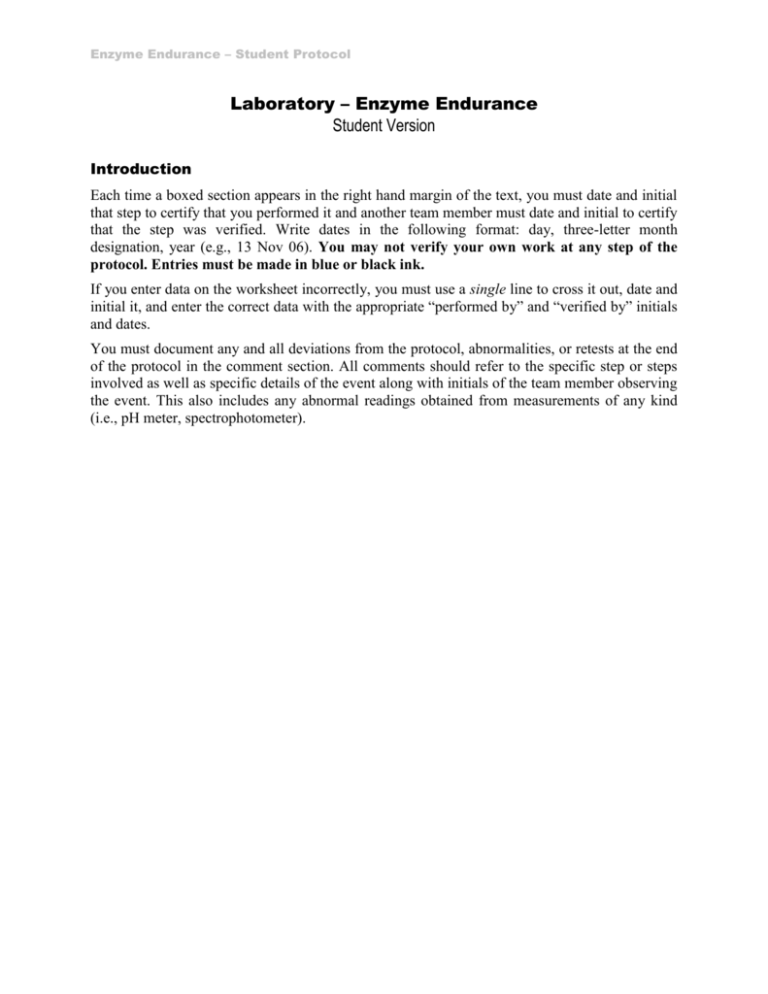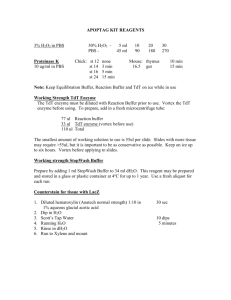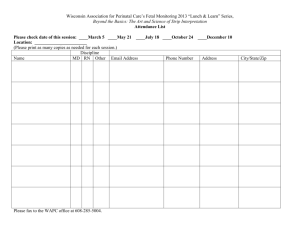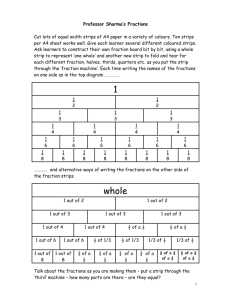Enzyme Endurance Laboratory Procedure - Bio-Link
advertisement

Enzyme Endurance – Student Protocol Laboratory – Enzyme Endurance Student Version Introduction Each time a boxed section appears in the right hand margin of the text, you must date and initial that step to certify that you performed it and another team member must date and initial to certify that the step was verified. Write dates in the following format: day, three-letter month designation, year (e.g., 13 Nov 06). You may not verify your own work at any step of the protocol. Entries must be made in blue or black ink. If you enter data on the worksheet incorrectly, you must use a single line to cross it out, date and initial it, and enter the correct data with the appropriate “performed by” and “verified by” initials and dates. You must document any and all deviations from the protocol, abnormalities, or retests at the end of the protocol in the comment section. All comments should refer to the specific step or steps involved as well as specific details of the event along with initials of the team member observing the event. This also includes any abnormal readings obtained from measurements of any kind (i.e., pH meter, spectrophotometer). Enzyme Endurance – Student Protocol Section 1 – Set Up STEP Instructions 1.0 Put on appropriate safety equipment: lab coat, safety glasses and gloves. NOTE – If protocol is interrupted and you must leave immediate area, remove lab coat, gloves and safety glasses and put on fresh gloves before restarting. 1.1 Review the experiment and ensure that all items necessary to complete the protocol are available. 1.2 Find and assemble all items of labware listed below. pH Meter and pH buffer standards Thermometer Magnetic stir plate, magnetic stir bars Scale Whatman #1 Filter Paper Tweezers Microscope slides Incubator/Oven (370-400) Spectrophotometer and cuvettes Beakers Graduated cylinder Micropipettors and tips Stop watch/timer Vortex 1.3 Find and assemble all chemicals listed below. (Check MSDS for all chemicals to ensure safe handling) Citric acid, FW 192.1 Dibasic Sodium Phosphate, FW 268.07 Peroxidase, from Horseradish 30% H2O2 Guaiacol Performed By Date Initial Verified By Date Initial Enzyme Endurance – Student Protocol 1.4 Ensure all labware is clean and has been rinsed with deionized H2O and is completely dry. Time/Date cleaned Items are dry yes no Enzyme Endurance – Student Protocol STEP Instructions 1.5 Check that all scales, stir plates and spectrophotometer to be used are in working order. List all equipment to be used below. Include manufacturer, model number, calibration date and calibration vendor, performed by and verification date and initials required for each item. 1.6 Ensure lab bench or work surface is clear of all items not pertaining to protocol and has been decontaminated. Wash solution used Time/Date cleaned Surface is completely dry yes no Performed By Date Initial Verified By Date Initial Enzyme Endurance – Student Protocol Section 2 – pH Buffer Standards NOTE – If commercially prepared buffer standards are available they may be used; pH strips may also be used. STEP Instructions Performed By Date Initial 2.0 If using commercially prepared pH buffers record the data below. pH 4 buffer manufacturer lot number expiration date 5ml sample taken date time pH 10 buffer manufacturer lot number expiration date 5ml sample taken date time 2.1 If using pH strips test both buffer standards and attach dried strips below. pH 4 strip 2.2 pH 10 strip NOTE – If Section 2.0 is not used, Section 2.1 must be used and vice versa. If a section is not used, mark all empty spaces with N/A. 2.3 pH meter standardized with pH buffer standards calibration date manufacturer model number standardized yes no Verified By Date Initial Enzyme Endurance – Student Protocol Section 3 – Enzyme Buffer Preparation STEP Instructions 3.0 Prepare 0.1 M Citric Acid Weigh out 0.96g citric acid, anhydrous, FW 192.1 scale calibration date scale tared Citric acid: Manufacturer lot number expiration date amount used 0.96g +/- 0.01g Dissolve citric acid in 40ml diH20 Addition time/date______________ Stir speed_____________ Hydrated completely yes no Time/date_____________ Bring to final volume of 50ml with diH20. Label 0.1M citric acid. 3.1 Prepare 0.2 M Dibasic Sodium Phosphate Weigh out 2.68g dibasic sodium phosphate (Na2HPO4•7H2O), FW 268.07 scale calibration date scale tared Dibasic sodium phosphate: Manufacturer lot number expiration date amount used 2.68g +/- 0.01g Dissolve dibasic sodium phosphate in 40ml diH20 Addition time/date______________ Stir speed_____________ Hydrated completely yes no Time/date_____________ Bring to final volume of 50ml with diH20. Label 0.2M dibasic sodium phosphate. Performed By Date Initial Verified By Date Initial Enzyme Endurance – Student Protocol STEP Instructions 3.2 Prepare Citrate-Phosphate Buffer, pH 5.0 Mix 24.3ml 0.1M citric acid with 25.7ml 0.2M dibasic sodium phosphate and bring final volume to 100ml with diH20 Obtain pH of buffer pH If pH of buffer is not 5.0, adjust with either the 0.1M citric acid solution or the 0.2M dibasic sodium phosphate solution. Label citrate-phosphate buffer, pH 5.0. If using pH strips, attach dried strip below. 3.3 Measure temperature of citrate-phosphate buffer 22C +/- 5 temperature Performed By Date Initial Verified By Date Initial Enzyme Endurance – Student Protocol Section 4 – Enzyme Strip Preparation STEP Instructions 4.0 Wearing gloves, measure and cut two 1cm x 2cm Whatman filter paper #1 strips. Handle with tweezers. Obtain a microfuge tube of 0.5mg/ml peroxidase, 1% Bovine Serum Albumin (BSA) solution. Carefully place the two membrane strips on a clean glass slide, and spot each strip with 20µl of the solution. Spot over the entire surface of the strip if possible. DO NOT TOUCH WET STRIPS. Use tweezers whenever handling strips. 4.1 Place strips in oven to dry. Temperature must be between 37-40C. 4.2 Closely monitor drying process. Check for strip dryness every 15 seconds. Use tweezers if it is necessary to touch strip when checking for dryness. Drying may take only 1–2 minutes depending on oven temperature. Strips must be completely dry. drying start time drying end time strips are completely dry yes no 4.3 peroxidase addition time filter paper drying end time difference of two times difference of two times is less than one hour yes no 4.4 Place strips in a sealable plastic bag and seal shut OR proceed directly to Enzyme Activity Assay. Performed By Date Initial Verified By Date Initial Enzyme Endurance – Student Protocol Section 5 – Clean Up STEP Instructions 5.0 Discard remaining buffer amount discarded 5.1 Clean all labware, equipment and surfaces. Performed By Date Initial Verified By Date Initial Enzyme Endurance – Student Protocol Section 6 – Comments STEP Instructions 6.0 Record all abnormalities, retests, and deviations Performed By Date Initial Verified By Date Initial Enzyme Endurance – Student Protocol Section 7 – Audit STEP Instructions 7.0 Ensure all pages are complete 7.1 Ensure all pages are in order 7.2 Ensure all initials and dates are present 7.3 Ensure all non-applicable sections are marked with N/A 7.4 Ensure Section 5.3 is complete and difference between peroxidase addition time and strip dry time is less than 1 hour 7.5 1st Auditor signature date Performed By Date Initial 2nd Auditor signature date Time and date documentation turned into QA inspector (instructor) Verified By Date Initial Enzyme Endurance – Student Protocol Section 1 – Enzyme Activity Assay STEP Instructions 1.0 Turn on spectrophotometer and allow instrument to warm up at least 10 minutes manufacturer calibration date Set wavelength at 500nm yes no To prepare 10mM H2O2: add 11µl 30% H2O2 to 10ml diH2O. Label 10mM H2O2. To prepare 25mM guaiacol: add 2.8µl guaiacol to 10ml diH2O. Label 25mM guaiacol. Blank instrument with a solution of 5ml citrate-phosphate buffer 2ml 10mM H2O2 1ml 25mM guaiacol 1.1 Place one enzyme strip in a small beaker with 5ml of citrate-phosphate buffer. Gently vortex for entire 2 minutes. strip added to buffer time strip removal time 1.2 Transfer enzyme/buffer solution to a test tube. In an additional test tube, mix 2ml 10mM H2O2 1ml 25mM guaiacol Add H2O2 and guaiacol mixture to enzyme/ buffer solution and immediately place in a cuvette. 1.3 Place cuvette into spectrophotometer and read Abs at 500nm over 2 minutes every 15 seconds. Record results below. Each reading needs a time entry, performed by and verified by, initials and date. Performed By Date Initial Verified By Date Initial Enzyme Endurance – Student Protocol STEP Instructions 1.3a Performed By Date Initial Time Reading Time Reading Strip 1 Strip 1 Strip 1 Strip 1 Strip 1 Strip 1 Strip 1 Strip 1 Strip 1 Color 1.3b Strip 2 Strip 2 Strip 2 Strip 2 Strip 2 Strip 2 Strip 2 Strip 2 Strip 2 Color 1.4 Chart observations and attach as last page of this protocol. Use an Excel spreadsheet or other data management application. Show raw data with headings and a graph with x and y axes labeled at set intervals. Verified By Date Initial Enzyme Endurance – Student Protocol Section 2 – Clean Up STEP Instructions 2.0 Discard remaining buffer amount discarded 2.1 Clean all labware, equipment and surfaces. Performed By Date Initial Verified By Date Initial Enzyme Endurance – Student Protocol Section 3 – Comments STEP Instructions 3.0 Record all abnormalities, retests, and deviations Performed By Date Initial Verified By Date Initial Enzyme Endurance – Student Protocol Section 4 – Audit STEP Instructions 4.0 Ensure all pages are complete 4.1 Ensure all pages are in order 4.2 Ensure all initials and dates are present 4.3 Ensure all non-applicable sections are marked with N/A 4.6 Ensure that strips were soaked for 2 minutes at Section 1.1 4.7 Ensure that absorbance readings were taken every 15 seconds for 2 minutes at Section 6.3 4.8 1st Auditor signature date Performed By Date Initial 2nd Auditor signature date Time and date documentation turned into QA inspector (instructor) Verified By Date Initial








